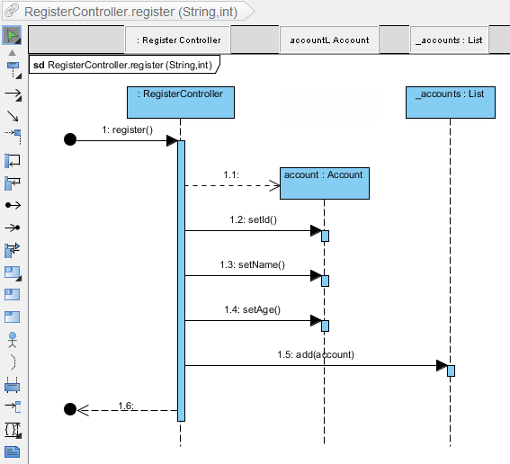

#Java code sequence diagram generator install
install - install the package into the local repository, for use as a dependency in other projects locally.verify - run any checks on results of integration tests to ensure quality criteria are met.package - take the compiled code and package it in its distributable format, such as a JAR.These tests should not require the code be packaged or deployed test - test the compiled source code using a suitable unit testing framework.compile - compile the source code of the project.validate - validate the project is correct and all necessary information is available.A Build Lifecycle is Made Up of PhasesĮach of these build lifecycles is defined by a different list of build phases, wherein a build phase represents a stage in the lifecycle.įor example, the default lifecycle comprises of the following phases (for a complete list of the lifecycle phases, refer to the Lifecycle Reference): The default lifecycle handles your project deployment, the clean lifecycle handles project cleaning, while the site lifecycle handles the creation of your project's web site. There are three built-in build lifecycles: default, clean and site. What this means is that the process for building and distributing a particular artifact (project) is clearly defined.įor the person building a project, this means that it is only necessary to learn a small set of commands to build any Maven project, and the POM will ensure they get the results they desired. Maven is based around the central concept of a build lifecycle. Setting Up Your Project to Use the Build Lifecycle.From whtever i understood we need to create instances like to make this work ? ProxyFactory pf = ProxyFactory.getInstance(a) Foo foo = (Foo) pf.extend(Foo.class) Am I right ? Suppose if i want to create the sequence diagrams all the methods in my application do i need to create the objects as above.Introduction to the Build Lifecycle Table Of Contents

i will really apreciate your help! 8:13 PM Unknown said.Ĭan we make this work on binaries. could you tell me if it can make any king of evaluation or review to a sequence diagram?or maybe you know any program who can make it ?. and i see you are an expert on this ASPECTJ. i was trying to find a way to do the evaluation of a sequence diagram. What more do you need? 9:43 AM JiMe εїз said. Hello sir, i am a final year Computer Science and Engineering student doing my project on "Reverse Engineering of Aspect Oriented Programming".My aim is to bring the static(class) diagram and dynamic(sequence)diagram from the aspectJ code.I am half way through the process of developing a parser which generates the class diagram by using the aspectJ syntax and semantics and i am writing the code in Java.It would be of great help if you could give me some ideas for generating the sequence diagram. So, hopefully it will also be a killer app :) Check out for more info. Thanks Bob! As you know, we have released our first commercial product using AOP that provides transparent auditing for J2EE applications. If you use the beta release like I did, you have to remove the dynaop.remote package from the jar manually (or maybe you can exclude it in the pointcut?) because it has an errant import. You have to run the Dynaop jar through the AspectJ compiler, too. Public abstract static class Foo implements Bar The only change I made was to s.getDeclaringType().getSimpleName() with s.getDeclaringTypeName() because getDeclaratingType() returns Class and it has getName(), but not getSimpleName() method. We'll generate a sequence diagram of the last invocation. The following code mixes a Bar implementation into Foo and invokes a couple methods on the resulting object. As an example, we'll generate a sequence diagram for a Dynaop mixin method invocation. Pardon me as I go out on a limb here and risk confusing you by using two AOP frameworks at once. Rather than perpetuate retired code, I've implemented a more robust version using AspectJ. The idea is you need runtime information to generate complete sequence diagrams. In the demo, a simple method interceptor generated a SEQUENCE data file. It combined my old AOP framework with SEQUENCE, Alex Moffat's sequence diagram generator. Over the past couple weeks a few people have inquired about a demo I wrote a few years ago named jAdvise SEQUENCE.


 0 kommentar(er)
0 kommentar(er)
